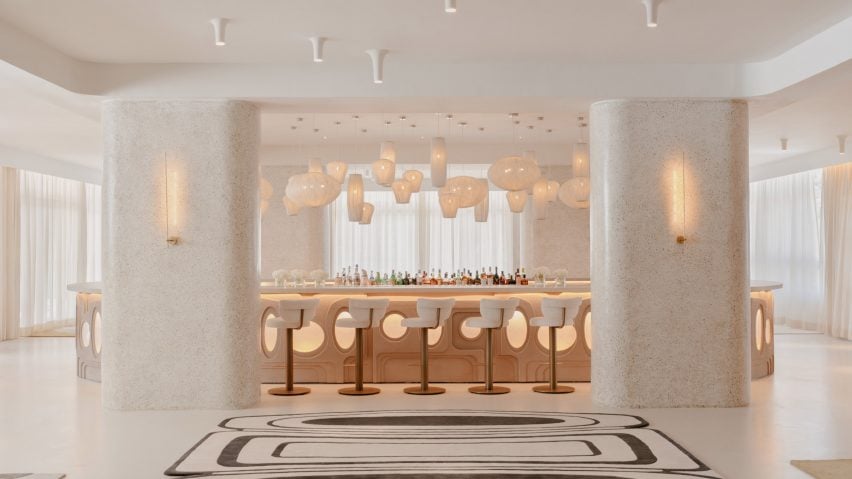Spanish studios Beades Architects and Cuarto Interior have revived a 1970s hotel property overlooking a bay in Ibiza, using local materials and mid-century furniture to transform its interiors.
The Mondrian Ibiza is perched on a steep hillside above the beach and turquoise waters of Cala Llonga, on the Balearic Island's east coast.
"The building was initially constructed as the first purpose-built hotel in the region in response to the growing number of bohemian tourists on the island," said the hotel team.
"Despite the launch of super clubs in many central hotspots, Cala Llonga, with its lush greenery, remained an oasis of slow living and authentic island life."
First built in 1972, the whitewashed structure steps back as it rises, creating spacious balconies for the front south-facing rooms.
The Mondrian group collaborated with Beades Architects and Cuarto Interior to reimagine the 154-room resort, which has an unusual layout that operators Ennismore had to rethink.
"Opposite to most guest journeys that are about getting you up to the roof, for this property you arrive on the higher level and gradually make your way down through the spaces to end up four floors lower on the beach," Ennismore's global VP of design Mark Eacott told Dezeen.
Arrival at the hotel brings guests into a whitewashed reception area on the fourth floor that's "inspired by the area's natural caves".
A gallery of contemporary art pieces and ceramics gently slopes down to a niche enveloped in indigo blue, which forms the check-in area.
A variety of mid-century-style furniture pieces forms lounge areas, while a giant patterned rug leads to the main Sun & Moon bar framed by four chunky rounded columns.
Approachable from all sides, the bar counter front is carved with reliefs and inset with circular lights designed to emulate the silver bracelets sold at the island's markets.
Guest rooms on the upper levels are arranged either side of a long corridor, and oriented at an angle so that their sliding windows face the best views and balconies don't overlook the neighbours.
In the guest rooms, the decor continues the Mondrian's neutral scheme while incorporating accents like woven leather headboards and textured linen curtains.
Slatted wood cabinets are designed to evoke the fisherman's dry docks found on the coves and beaches across the island.
Mondrian Ibiza is connected to a sister property, Hyde Ibiza, and shares several common facilities across the lower terraces.
These include a swimming pool, bar and lounge area, while another pool is reserved for Mondrian guests – both surrounded by cabana beds.
Between the two hotels, guests have access to seven restaurants and bars, including Mexican eatery Cuyo on the Hyde's upper terrace, and a Japanese dining experience called Nico on the Mondrian's third floor.
For casual fare during the day, the poolside Bungalow bar and grill offers bites and cocktails in a tropical-themed space that spills outdoors.
Art placed throughout the hotel is curated by London-based collective Gone Rogue, and includes resin sculptures by Corine van Voorbergen in the lobby.
"The hotel bears all the aesthetic hallmarks of a Mondrian, yet there is a softness, and an element of movement conveyed through structural curves, organic shapes and sculptural fluidity that speaks to the island," Eacott said.
Ibiza offers a wealth of options for tourists looking for a relaxing getaway, as well as those arriving to enjoy the famed nightlife.
In Ibiza town, the Montesol Experimental and The Standard hotels cater to a younger crowd, while countryside retreats like Aguamadera and Campo Atelier provide guests with a slower pace.

